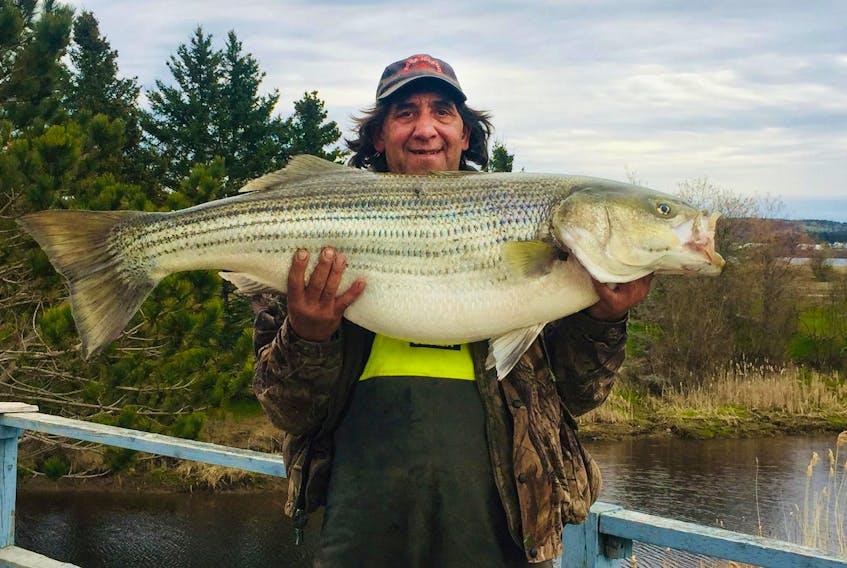ANNAPOLIS ROYAL, N.S. — The sun was just breaking over the Annapolis River on Tuesday morning when Chad Cook cast his line.
It was a sleepy beginning to what would be another long day on the river.
He’d fish until the tide dropped, go dig clams for six hours, then go back to fishing.
Six hours a day bent over digging in the mud with a little metal shovel called a hack to pay the bills and six hours with a rod for pleasure and food.
This is how the 48-year-old has spent between five and seven days a week from April 15 to Dec. 1 since he was 15.
“It doesn’t leave a lot of time for sleeping,” said Cook.
“We eat a lot of fish in my house.”
On Tuesday morning something marvelous happened.
“I let the drag off and I could just hear the line screaming out,” said Cook.
“I couldn’t do nothing with him, he was just taking line down river. When he surfaced it was just breaking daylight, I saw his dorsal fin and thought ‘this is a monster.’”
But it took him half an hour fighting the striped bass on 20-pound test line to realize how much of a monster it was.
The 114-centimetre-long fish would weigh in at close to 22 kilograms.
And this just before breeding season on a river where the local population was supposed to have been largely killed off by a causeway built in 1960, and again by a tidal generating station that opened in 1984.
Cook’s big catch has raised eyebrows among the river’s many advocates.
“If there’s fish going back up there and that water is left to free flow a bit more maybe it could propel a re-colonization,” said Trevor Avery.
The associate professor of both biology and mathematics at Acadia University has taken a sample of Cook’s big fish for genetic testing. He wants to know where it came from.
Annapolis River flowing freely
According to Fisheries and Oceans Canada, striped bass used to spawn in the Saint John, Annapolis and Shubenacadie river systems on the Bay of Fundy. The causeway built across the Annapolis River in 1960 and the Annapolis Royal Tidal Generating Station that opened in 1984 have been widely blamed for driving the fish from that river. Meanwhile the Saint John population dropped off after the Mactaquac Dam was built in 1968.
But, after decades of protests by local residents and revelations in The Chronicle Herald that Nova Scotia Power was not relaying reports it received from the community about Atlantic sturgeon allegedly killed by its turbine to the federal regulator, Fisheries and Oceans Canada ordered a review of existing scientific data on the turbine’s effects. Based on the review’s findings, Fisheries and Oceans told NSP in April 2019 that it would no longer be permitted to operate the turbine without being first granted an exemption to kill fish under Section 35 of the Fisheries Act. At the time, a Nova Scotia Power spokesman said the plant had been shut down since January.
Since then the gates have been open on the Annapolis River, allowing the water to flow freely with the tide and also, presumably, for fish to travel through.
“If you look at the Penobscot River in Maine or the Peticodiac River in New Brunswick we have examples of where, when you remove that infrastructure and make changes, you can see species returning to a river and it’s not just striped bass,” said Avery.
Through the 1960s people were dumping rocks in rivers and paving roads over them throughout Atlantic Canada, encouraged by federal dollars for the infrastructure projects that would also protect farm and development land further up river.
“It wasn’t just that they were cheap, it was also that you could get someone else to pay for them,” said Edmund Redfield, a fisheries biologist with Fort Folly Habitat Recovery.
“There was actually one place on the Memramcook where they replaced a bridge with a causeway, which doesn’t make a lot of sense.”
Among the rivers his organization has been working on in southern New Brunswick is the Petitcodiac.
A causeway was put across what had been a kilometre-wide section of that river in 1968.
"When I was a kid any culvert coming out of the river you could stand there and fill a bucket with white perch. The last 10 years I don’t think any were caught in the river.
- Chad Cook, fisherman
Runs of shad dropped off immediately, striped bass stopped coming up the river, salmon began a long decline that resulted in extirpation and tom cod were shut out, too.
Then, in 2011, they opened up the gates, allowing the water to flow freely.
Striped bass are back in heavy numbers, though there’s no evidence yet as to whether they are successfully spawning in the river.
Shad, too, are returning in greater numbers every year.
“Recovery is slow but we are seeing progress,” said Redfield.
“One of challenges we face is that there’s not as much information about what pre-causeway conditions were like to make it easy to make comparisons.”
Back in Annapolis Royal, Cook is even noticing a difference on his clamming beds since the turbine stopped spinning.
The beds are covered in less silt, which can smother juvenile clams.
“When I was a kid any culvert coming out of the river you could stand there and fill a bucket with white perch,” said Cook.
“The last 10 years I don’t think any were caught in the river. This year there is all kinds.”
As for what he’ll do with the striped bass he considers the catch of a lifetime: some of it will get cut up as steaks and some as fillets.
How it’s cooked will depend on who’s at the stove.
His wife, Ashlie, prefers it pan-fried while he thinks deep fried is best.
Nova Scotia Power provided a written response to The Chronicle Herald stating that there is no update on its idled facility.
RELATED:









